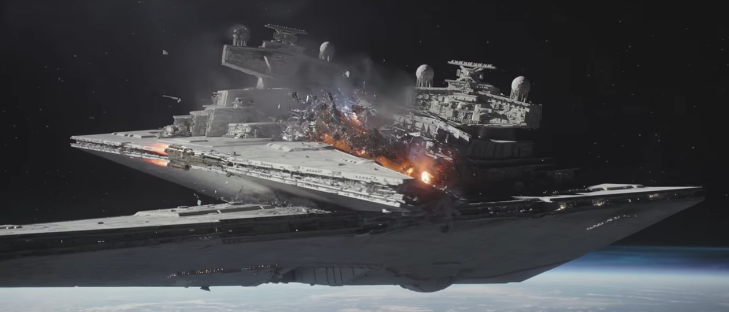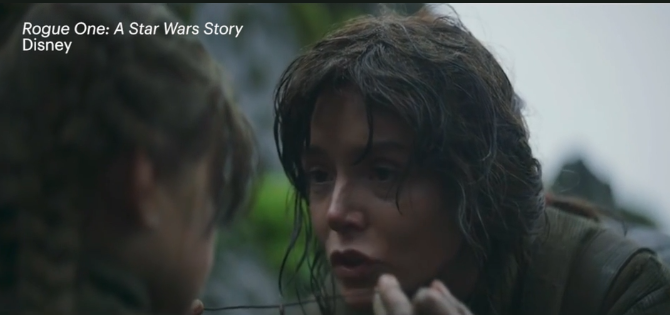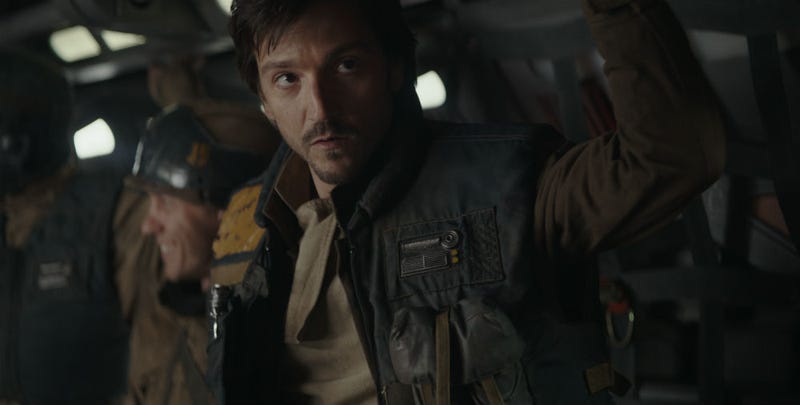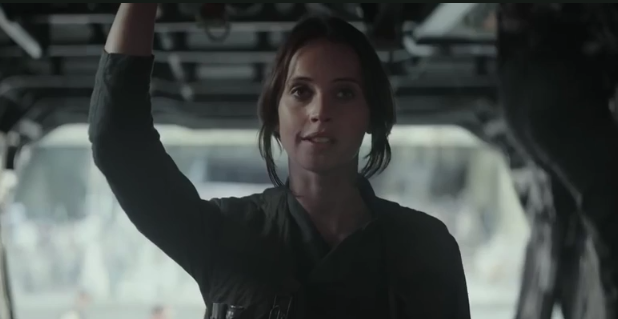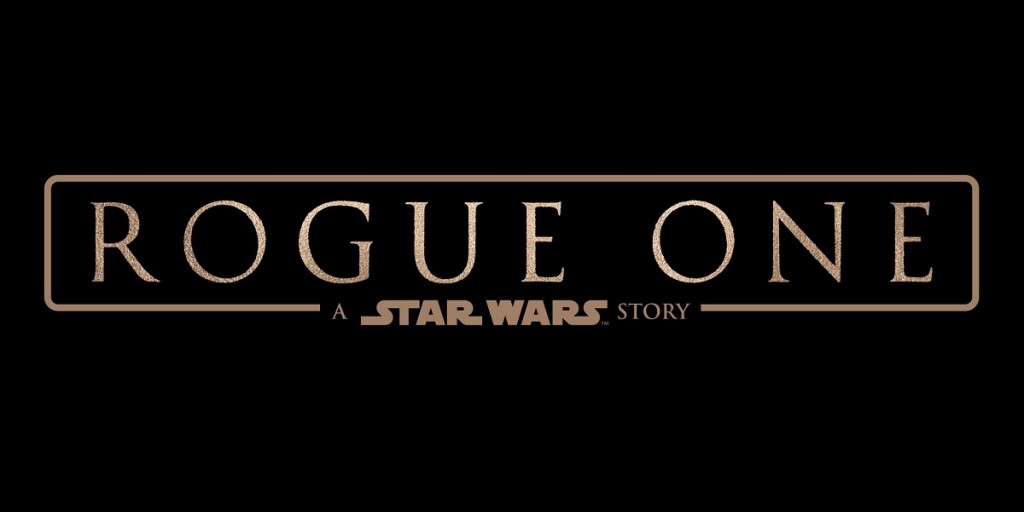Category Archives: Rogue One
Rogue One: A Star Wars Story “The Lovable K-2SO”
Rogue One: A Star Wars Story “Designing K-2SO”
John Knoll Interview About VFX Shots in Rogue One
Via Slashfilm.com:
A couple weeks ago, /Film had a chance to visit Industrial Light and Magic for a press event ahead of the home video release of Rogue One: A Star Wars Story. While there, executive producer and visual effects supervisor John Knoll gave us a keynote presentation showing off the hard work that went into the various visual effects in Rogue One, from the creation and destruction of Jedha to the seamless, impressive use of virtual sets. But we’ll have more on that later this week in honor of the movie’s arrival on Blu-ray and DVD.
Right now, we have an interview with Knoll where he told us how many visual effects shots were in Rogue One (including comparing the number to the rest of the Star Wars library), why recreating concept artist Ralph McQuarrie‘s designs for the Death Star with visual effects was so difficult, and much more about the visual effects of the movie.
How does it feel to come out of Industrial Light and Magic, working on previous Star Wars movies in visual effects, to all of a sudden being the bearer of this story, the one shepherding it and guiding it into existence?
Well, it’s a little surreal. It started off just as almost joking pitches to friends of mine here that got interestingly positive reactions. That led to me doing a mental exercise of if we were going to turn this into a feature, what would the inciting incidents be here? How does the plot fit nicely into the constraints that are posed by the things that we know in Episode IV, from the crawl and some of Vader’s dialogue? What are the things that have to have happened in this film for that to make sense? Who are the characters and what are their agendas through the picture with the conflicts?
I started working through a bunch of that stuff mentally. Then people would ask, “Vic told me you have a Star Wars story that’s really cool.” I would do the pitch and then finally I did this very elaborate one that spanned about 20 minutes, and at the end of that a friend of mine said, “C’mon you have to pitch this to [Kathleen Kennedy]. You have to.” As soon as he said that, I realized he’s right, I kinda to have to, because if I don’t I’m always going to wonder what would have happened if I did. So I thought, I’ll make the appointment and see if Kathy will humor me in listening to this pitch.
The day came, and I had a half hour with Kathy and Kiri [Hart, a story analyst, writer, and development executive at Lucasfilm], took them through the whole idea of who the major characters were, thematically what did I see this as.
Did you have a pitch reel that went with the presentation?
No, it was all just written material. I’d written up kind of a dense prose, six page version of the treatment with the description of the characters. I just took them through that. And at the end of that Kathy said, “All right, thank you.” I said, “Thanks for listening,” got up and left and I didn’t hear anything for a little while. But I thought, at least I did it. I’m not gonna wonder.
About a week after I got an e-mail from Kiri that said, “We’ve been talking about this a lot, and we think we may want to proceed with it.” It was really exciting to get that and it sort of gradually snowballed about what we got here.
Click below to read the full article.
Star Wars: Rogue One As Told By LEGO
How ‘Rogue One’ Was Made To Look And Feel Seamless Within The Star Wars Saga
Via Digitaltrends.com:
While fans were reticent at first about a new series of films set inside the Star Wars universe — but outside the main episodes — Rogue One: A Star Wars Story quickly proved that George Lucas’ epic space opera was much bigger than the story that played out across the first seven films (and counting).
Set between the events of Star Wars: Episode III – Revenge of the Sith and the franchise-spawning Star Wars: Episode IV – A New Hope, Rogue One followed a ragtag group of rebels tasked with stealing the plans to the Death Star. Along with telling the story of the dangerous mission, director Gareth Edwards and Rogue One’s creative team also faced the daunting task of inserting the tale into the Star Wars timeline in a believable way — not only would the story itself have to align with the saga’s timeline, but the sets, costumes, and even the technology would need to seamlessly blend with the 1977 film that started it all.
Taking a lead role on the technology side of things was Doug Chiang, a Lucasfilm vice president and executive creative director, who served as the co-production designer on Rogue One. Chiang previously led Lucasfilm’s art department during the production and release of Star Wars: Episode I – The Phantom Menace and Star Wars: Episode II – Attack of the Clones, and served as a concept and co-production designer for 2015’s Star Wars: Episode VII – The Force Awakens.
Digital Trends spoke to Chiang about the process of integrating Rogue One into the Star Wars universe and making a standalone story feel like an important thread in the Star Wars tapestry.
Click below to read the full article.
First Look – Rogue One: A Star Wars Story Blu-ray DVD In Hand Unboxing
Rogue One Join The Rebellion Press Pack!
Rogue One Producer Has Another Star Wars Spinoff Idea
Via Screentrant.com:
Rogue One: A Star Wars Story, the first Star Wars spinoff film from Lucasfilm, began as an idea from ILM’s John Knoll. Though he initially wasn’t sure how serious he was, Knoll received encouragement from friends to pitch the concept to Lucasfilm president Kathleen Kennedy, and the rest is history. Rogue One was one of the most successful movies of 2016, earning positive reviews from fans and critics while grossing over $1 billion at the worldwide box office. Despite all the concern about the reshoots that took place last summer, the final product was quite strong and proved Star Wars could live beyond the Skywalker saga.
After hitting a home run with Rogue One, it’d be understandable if Knoll decided to just focus on visual effects and leave pitching to the several others who have ideas for the next great Star Wars film. However, Knoll isn’t one to rest on his laurels, and perhaps buoyed by the response to Rogue One, has another standalone he’s currently working on.
Screen Rant visited ILM for a Rogue One press event and spoke with Knoll. When asked if he has any other stories in mind, Knoll revealed he’s making progress on his second spinoff:
“I do have one more idea that I may or may not pitch. I’ve got it about 3/4 figured out and if I can solve that last portion of it, I’ll see if Kathy’s interested. She may throw me out of her office.”
Given the secretive nature of Lucasfilm, Knoll obviously could not reveal any specifics about what the main narrative might entail, but with the broad scope of the Star Wars universe in mind, the possibilities are virtually limitless. Based on his comments, this isn’t something he’s ready to pitch right now, and it will be interesting to see if he can crack that last quarter and present it to Kennedy. Should Knoll formulate a full outline, Kennedy would most likely be curious to hear what he has in mind, since Rogue One was a hit. Knoll certainly has some storytelling talent. He offered that he thought it was a “cool” idea, so there’s probably something there.
Though Disney plans to release new Star Wars movies annually for the foreseeable future, the studio’s officially confirmed slate is somewhat small when compared to other high-profile properties like the Marvel Cinematic Universe. Outside of The Last Jedi and Episode IX, the only other project said to be in development is the young Han Solo film. No other standalones have been announced, though that could change by the time Star Wars Celebration and D23 roll around this year. With the future of the anthology movies up in the air, Knoll’s next pitch could theoretically come through the pipeline sooner rather than later, depending on how things shake out.
Jyn Erso’s Mother Was A Slain Jedi In An Early Version Of Rogue One
Via Ew.com:
Which paths through the galaxy weren’t taken? That’s a question Star Wars fans still have about Rogue One, and EW will be providing answers this week leading up to the movie’s digital debut on Friday. (It’s out on Blu-ray April 4.) Next up in our Rogue One Revelations series:
Jyn’s mother was once a Jedi, and her death would have happened in the prequel trilogy era.
By now we all know Rogue One touches right up against the start of 1977’s original Star Wars, but one early story idea was to have it clearly serve as a bridge to George Lucas’ prequel trilogy and the Clone Wars.
“The prologue, at one point a long time ago, was going to be the Empire coming to kill the Jedi,” says director Gareth Edwards. “And Jyn’s mom was going to be a Jedi.”
The math holds up. If Jyn is in her early to mid-20s for most of the movie, and 19 years have passed between the events of Revenge of the Sith and A New Hope, then she would have been about 4 to 6 years old when the Emperor unleashed Order 66 to exterminate the Jedi.
Edwards says the initial prologue concept for Rogue One was, “We were witnessing one of those kills and Krennic would be the person sent to do it.”
Star Wars is full of lost children, striving to survive on their own, relying on the care of others: Luke, Leia and, in a darker sense, Anakin Skywalker/Darth Vader himself. In The Force Awakens and the animated Rebels series, Rey, Finn, and Ezra Bridger also fit this archetype of the abandoned innocent who finds a new family in a fight against the forces that stole their loved ones. Chris Weitz, one of the movie’s screenwriters, previously hinted at Jyn’s mother’s mystical origin in an interview with Yahoo Movies, but this is the first time filmmakers have revealed details of that alternate storyline.
The fatal flaw in the concept was that Jyn was never going to become a Force-wielder, so the filmmakers feared her Jedi mother would become a distraction. A tease without a payoff.
“Our instinct told us that we wanted a scene where Jyn is orphaned because of what Krennic does, which sets her on her path of being a child of war,” says Edwards. “The problem was that the second you make her mom a Jedi you spend the entire movie questioning whether Jyn is a Jedi or not. Eventually, we came up with the idea that her father should have designed the Death Star. That became a stronger way into the stealing of the Death Star plans. We let go of the mother being a Jedi, and she became just a rebellious mom.”
Click below to read the full article.
Another Ending That Was Planned For Rogue One
Via io9.com:
Here’s a hint: it involved carbon freezing.
As we all know, Rogue One: A Star Wars Story went through innumerable iterations; some of them you saw in trailers and on the big screen, others never made it that far. Recently, Rogue One’s first writer Gary Whitta revealed an alternate, happier ending where Jyn and Cassian survived. However, that wasn’t the only alternative ending according to the creator of Rogue One’s story, John Knoll.
John Knoll is the Chief Creative Officer and Senior Visual Effects Supervisor for Industrial Light & Magic, the visual effects house that works on Star Wars as well as dozens of other films. He was also the person who originally came up with and pitched the idea of making a movie about stealing the Death Star plans. Before any writers were hired, he came up with several different versions of the story.
We were at ILM to talk to Knoll about the upcoming Rogue One home release, but when we asked him about the “happy ending” revealed earlier this week, he gladly told us about a few other possible endings that were considered for the film. These two started the same way, but then broke off into two different paths.
1) Fleeing to Coruscant
Jyn and Cassian lead a team that steals the Death Star plans, and escape Scarif on a Rebel ship. In hot pursuit is Darth Vader, whose ship keeps attacking them even after multiple jumps to lightspeed. Soon, they’ve taken so much damage, they realize they aren’t going to make it.
“And the last jump they do, they try to get lost in the traffic that’s around Coruscant,” Knoll said. “It’s a giant cloud of ships. Ten-thousand ships coming and going and they’re trying to get lost in that traffic but they don’t make it. There’s still an hour’s flight away from Coruscant and their ship gets damaged.”
Jyn and Cassian realize if they don’t get the plans off the ship, the whole mission has failed. “So they discover that Leia’s ship has just taken off from Coruscant and is on its way to its diplomatic mission to Alderaan,” Knoll said. “They know that she’s secretly working for the Rebellion and they risk blowing her cover by transmitting the plans to her ship with the hope that this transmission won’t be detected but Vader’s ship.”
Obviously, it is detected, but Jyn and Cassian realize that whether Vader catches Leia’s ship or not, they will inevitably be tortured for information by the Empire and could reveal the Rebellion’s secrets, potentially leading to its destruction. So the two Rebels decide to blow up their ship with them on it.
Click below to read the full article.
Riz Ahmed Almost Played An Engineer Named Bokan In Rogue One
Via Ew.com:
Which paths through the galaxy weren’t taken? That’s a question Star Wars fans still have about Rogue One, and EW will be providing answers this week leading up to the movie’s digital debut on Friday. (It’s out on Blu-ray April 4.) Today in our Rogue One Revelations series:
Before he was Bodhi Rook, Riz Ahmed was playing a crazed, imprisoned engineer named Bokan …
Who am I?
That’s the soul-searching question of Bodhi Rook, the defecting Imperial pilot Riz Ahmed played in Rogue One, and throughout the Star Wars standalone film he answered that question with bravery and sacrifice. But in the original drafts of the story he didn’t even exist.
Ahmed took the job thinking he would play someone else.
“His name was Bokan, and he was actually Saw Gerrera’s engineer, living on a planet with a strong electromagnetic field, which meant that electronics were never working,” Ahmed says. “He was actually an Imperial engineer who had been kidnapped and kind of had Stockholm Syndrome. He had been living there for so long, he kind of lost it, like Dennis Hopper in Apocalypse Now.”
Bokan was still a key to unlocking the Death Star’s weakness, so he was sought by both heroes and villains alike. The moon Gerrera was using as a hideout protected their little crew of insurgents from all search parties, and the Rebel team led by Jyn Erso originally wrecked its U-wing trying to track them down.
“We knew we needed to ditch the U-Wing and get them on that Imperial shuttle that they used at the end. In the finished film, you see that scene happen on Eadu,” says Gary Whitta, who worked on the early screenplays.
Before that evolution in the story, the Rebels crash-landed amid the electrical storms of Gerrera’s moon. “When they try to land, there’s a ship graveyard, and that’s part of the reason the Empire’s never found [Gerrera],” says Gary Whitta, who worked on the early screenplays. “Saw has modified his ships to survive in that environment but nothing else can land.”
As everyone knows who saw the film, Bokan became Bodhi Rook, the pilot from Jedha who led Jyn Erso to her captured scientist father. The name change was symbolic, Ahmed says.
“Bodhi means awakening,” Ahmed says. “He’s a character who goes through kind of an enlightenment.”
Click below to read the full article.
Rogue One Almost Had Vader Killing A Major Character
Via Ew.com:
On Monday, we talked about a “happier ending” that was considered during the early stages of Rogue One: A Star Wars Story.
Tuesday’s subject is the much grimmer ending that almost faced another important character.
Darth Vader was always going to be used sparingly in Rogue One, but “spare” isn’t exactly in the Dark Lord’s personal lexicon.
In early drafts of the story, his merciless nature would have been highlighted not in a brutal lightsaber melee against a corridor full of Rebel soldiers, but in the cruel and unusual execution of a member of the Imperial high command.
“Vader is in the movie as much as he always was. He only had two things in the film. He was on Mustafar and then in the battle at the end,” says Gary Whitta, who wrote a version of the script that was then redrafted by Chris Weitz and later Tony Gilroy.
“The rampage where [Vader] murdered everybody wasn’t me. That got added later,” said Whitta, although he had considered a different battlefield confrontation between a large group of opponents and the Sith Lord. “I had pictured early on Vader murdering all these Rebel soldiers but I never wrote it into the script. It was an idea that stuck around after I left and they ended up finding a cool way to use it. It’s actually my favorite thing in the film.”
He did have a bonus Vader scene near the end that ended up being dropped from the storyline.
Click below to read the full article.
Rogue One Writer On Jyn Erso And Luke Skywalker’s Similar Goals
Via Comicbook.com:
One of the biggest story criticisms of Star Wars: The Force Awakens was how many aspects of the film felt like a rehash of the original Star Wars movie, A New Hope. Whether valid or not, there are many comparisons between plot points and themes that are easily noticeable.
But what about between the original film and Rogue One: A Star Wars Story?
Obviously the events of one film leads right into the other and they are closely related, but there are a few surprising themes that are echoed between both films.
Rogue One’s writer Gary White spoke with ComicBook.com’s own Patrick Cavanaugh about creating the story behind the film and how A New Hope’s characters and relationships influenced the themes behind the first Star Wars spinoff.
“John [Knoll] always had from the very beginning the idea that Jyn, her parents had been killed by the Empire, and that’s why she fought against the Empire, because she was kind of driven by revenge, this hatred of the Empire, and then that kind of evolved as we went on,” Whitta said.
“We came up with the idea that her father wasn’t killed, but he was kind of abducted by the Empire and forced to work on the Death Star, and that’s was kind of, I think, the big eureka moment for us when we figured out the idea that the father should be the scientist who kind of reluctantly helped the Empire build the Death Star, but was determined in someway to find a way out, to kind of undo the terrible wrong that he’d been forced to commit.”
Based on this organic plot development they had worked out, they happily came across a parallel between Jyn Erso’s journey compared to that of Luke Skywalker.
“So designing the flaw into the Death Star and then getting that information to his daughter, and in the same way that in the original Star Wars films, you know, Luke is trying to kind of redeem his father,” Whitta said. “I feel that in our film, in much in the same way Jyn’s trying to redeem hers, by completing the job that he started. By putting that fatal flaw in the Death Star and then trying to get the plans to the Rebellion so they can exploit it.”
It’s an apt comparison and one that isn’t as overt as, say, Starkiller Base and the Death Star. But it works just subtly enough to remind us of the past stories without being overtly on the nose.
Rogue One Alternate Ending Revealed
Via Ew.com:
Rogue One: A Star Wars Story filmmakers have said they always intended to kill off the entire Rebel team during their heist of the Death Star plans on the tropical world of Scarif. But in the very earliest script – before getting the go-ahead for that sacrificial ending – they came up with an escape plan.
“The original instinct was that they should all die,” screenwriter Gary Whitta tells EW. “It’s worth it. If you’re going to give your life for anything, give your life for this, to destroy a weapon that going to kill you all anyway. That’s what we always wanted to do. But we never explored it because we were afraid that Disney might not let us do it, that Disney might think it’s too dark for a Star Wars movie or for their brand.”
So in the original treatment by John Knoll, and in the first script by Whitta, a few of the key heroes survived the final battle. But the creative team still wanted their noble sacrifice.
“You have the darkness that’s in the undercurrent of the story at that point, but you still have the rightness of why they’re doing it,” says director Gareth Edwards. “It doesn’t feel depressing. It feels like you want them to succeed at any cost. It’s a sport where the clock is ticking, and they need to just dive across the finish line. You do whatever you need to do to get there. It’s a gauntlet that they’re handing to Princess Leia. You get that moment where the crowd feels like it can cheer at the end.”
So that argument had to be made to the Lucasfilm brass: the heroes would succeed in stealing the plans, but they should pay the ultimate cost for that victory.
“We were still scratching the itch that they all needed to die. Chris Weitz [who wrote another draft] thought we were right,” Whitta says. “They finally went off and fought for it. We told them, we feel they all need to die, and [Lucasfilm president Kathleen Kennedy] and everyone else said to go for it. We got the ending that we wanted.”

